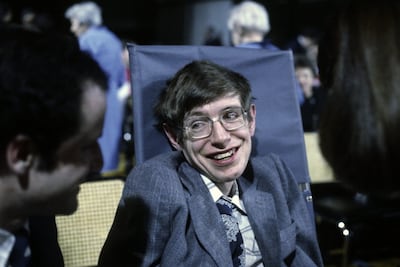Stephen Hawking was given a life expectancy of just two years when he was first told he had motor neuron disease (MND) in 1963.
The Englishman died this week, 55 years after the diagnosis, the world’s best-known physicist.
He survived for more than half a century with a debilitating and rare disease – amyotrophic lateral sclerosis (ALS), the most common form of MND – which is a cruel condition characterised by weakness and wasting in the limbs.
MND affects the nerves (motor neurons) in the brain and spinal cord that tell muscles what to do. As the nerves become damaged, the muscles they control weaken and waste. The muscles first affected tend to be those in the hands, feet or mouth and throat – depending on which type of the disease it is. It is not contagious.
It is often referred to as the 1,000-day disease as most people die within 1,000 days of the onset of symptoms. However, while MND is a progressive, life-limiting disease, the rate of progression varies greatly from one person to another.
And, while it is more common after the age of 50, it can strike any age.
Hawking was only 20 when he began to fall over inexplicably and his speech became slurred - both common indicators of the onset of MND.

The disease took hold slowly, damaging the nervous system, which leads to muscle weakness, stiffening and waste. Eventually, he was unable to move, talk, or even swallow and breathe without medical help.
“In my third year at Oxford, I noticed that I seemed to be getting more clumsy, and I fell over once or twice for no apparent reason,” he wrote many years ago. “But it was not until I was at Cambridge that my father noticed, and took me to the family doctor. He referred me to a specialist, and shortly after my 21st birthday, I went into hospitals for tests . . . it was a great shock to me to discover that I had motor neuron disease.”
He still managed to have a long and, by any measure, incredible career as a theoretical physicist, cosmologist and author. It may be known as the 1,000-day disease, but Hawking survived more than 20,000 days after his diagnosis.
Life expectancy for people with motor neuron disease appears to be dependant on two things – the motor neurons controlling the breathing muscles in the diaphragm, and those affecting the swallowing muscles. The most common way for people to die is of respiratory failure, and therefore how progressive the disease is in this area in particular is crucial.
Regardless, Prof Hawking’s long life has confused and astounded experts in the field of MND. While he undoubtedly received excellent medical care during the past five decades, it is considered more likely that his beating the odds was down to the biology of the disease.

There are 120 number of new cases of MND diagnosed in Ireland every year, with more than 380 people currently living with the condition in the State.
"Stephen Hawking was an inspiration to so many," says Aisling Farrell, head of the Irish Motor Neurone Disease Association (IMNDA). "He never let his illness define or limit him. Throughout his life he did so much to raise awareness of motor neuron disease around the world. Our condolences to his family during this sad time."
Hawking lived a remarkably long time with the disease – despite being paralysed and completely dependent on others. “I try to lead as normal a life as possible, and not think about my condition, or regret the things it prevents me from doing, which are not that many,” he wrote. “I have been lucky that my condition has progressed more slowly than is often the case. But it shows that one need not lose hope.”
While his long life after diagnosis is unusual, it is not without precedent – and even in Ireland there are cases of people being diagnosed with MND in their youth and living till old age.
Andy McGovern turned 85 last month. He was diagnosed with MND 42 years ago.

“At my initial diagnosis, I don’t think anyone thought I would be the longest MND survivor in Ireland,” said McGovern, “but I think I achieved that accolade with a combination of faith in God, many trips to Lourdes, the support of my family and my own positive outlook”.
The young age of McGovern and Prof Hawking when they were diagnosed may have contributed to their long lives. “We have found that the survival in younger patients (with MND) is strikingly better and is measured in many years – in some cases more than 10,” Nigel Leigh, a professor of clinical neurology at King’s College London, told the British Medical Journal in 2002. “It’s a different beast if you start young, oddly, and no one knows why.”
There is no cure for MND and no clear answer about what causes the condition.
That is not for the want of trying.
Researchers throughout the world have dedicated their lives to trying to unlock the secrets of MND. Last November, researchers in the Academic Unit of Neurology at Trinity College Dublin - a newly formed unit - announced they had made the surprising discovery that some specific parts of the brain are “over-connected” in MND, while other parts show reduced activity as the brain networks disintegrate.
And, last September, a consortium led by biomedical researchers at Ulster University were allocated funding from a US-based foundation to further explore the involvement of muscles in the progression of MND.
While there is no know cure, yet, the symptoms can be managed, with drugs such as Riluzole (Rilutek) helping to slow the disease’s progress.
MOTOR NEURON DISEASE SYMPTOMS
Early – Difficulty picking up or holding things, weakness in arms and legs, falling over, fatigue, muscle pain and cramps, slurred speech, difficulty swallowing or breathing.
Later – Muscle pain and spasms, muscles shrinking, joint pain, difficulty eating, drinking, swallowing and breathing.

MOTOR NEURON DISEASE TYPES
Amyotrophic lateral sclerosis (ALS) – The most common form, involving upper and lower motor neurons - characterised by weakness and wasting in the limbs. Average life expectancy is 2-5 years from onset of symptoms.
Progressive bulbar palsy (PBP) – Affects a quarter of people diagnosed, also involving upper and lower motor neurons. Life expectancy is between six months and three years.
Progressive muscular atrophy (PMA) – Affects a small proportion of people, involving damage to lower motor neurons. Most people live for more than five years.
Primary lateral sclerosis (PLS) – Rare , involving upper motor neurons. Usually characterised by weakness in lower limbs. Life expectancy depends on whether it develops into ALS, but could be normal.









